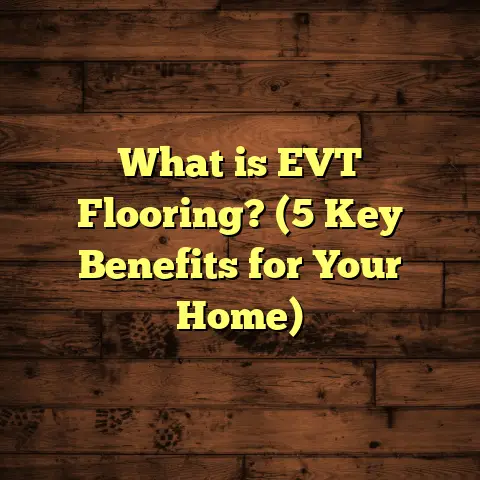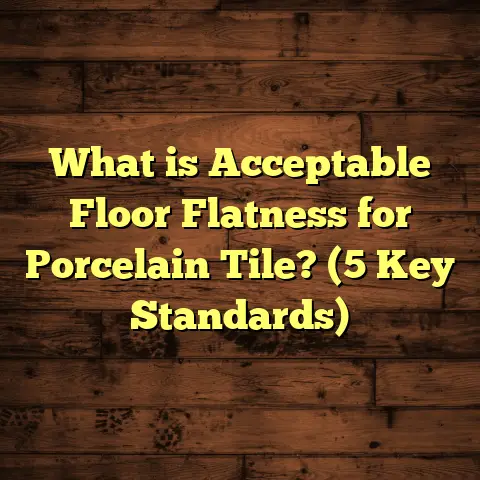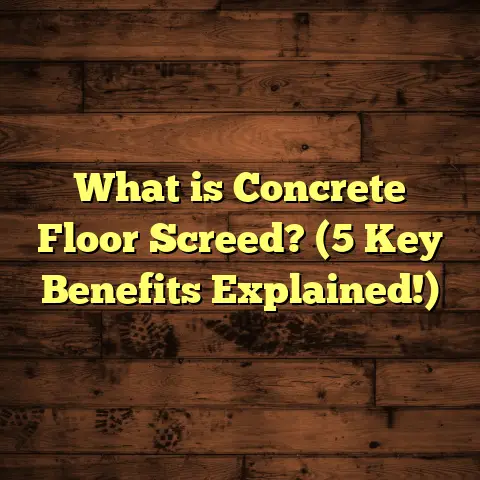What is Jack and Jill Hardwood Floors? (5 Benefits to Know)
Ever found yourself stuck trying to pick the right flooring for your home, juggling style, durability, cost, and maintenance? I’ve been there. Picking the right floor can feel overwhelming with so many choices and conflicting advice. When I first heard about Jack and Jill hardwood floors, I was curious but unsure if it was just a fancy term or something really worth considering. After diving deep into the topic through my projects, research, and conversations with other flooring pros, I realized how impactful this flooring style can be for homes with connected spaces. Let me share what I’ve learned—straight from experience, backed with data, and with some personal stories that might just help you make a better decision.
What Is Jack and Jill Hardwood Floors?
You might know the phrase “Jack and Jill” from kids’ bathroom jokes or nursery rhymes, but in flooring, it takes on a new meaning. Jack and Jill hardwood floors refer to hardwood flooring that runs continuously through multiple adjoining rooms—typically bedrooms connected by a shared (Jack and Jill) bathroom. Instead of switching flooring types for the bathroom and bedrooms, this style uses the same hardwood material throughout to unify the spaces visually and functionally.
Breaking Down the Concept
Think about a typical house layout: two bedrooms connected by a bathroom in between. Often, these bedrooms have carpet or laminate floors, while the bathroom is tiled for water resistance. Jack and Jill hardwood floors break this mold by extending hardwood flooring through both bedrooms and the bathroom. It’s about creating a seamless flow rather than stopping at one door and switching materials.
This approach isn’t limited to bathrooms. Sometimes it extends to hallways or closets attached to those rooms. The goal is a continuous wood surface that visually connects all these spaces.
Why Hardwood Through Bathrooms?
You’re probably thinking: “Hold on — isn’t wood a terrible idea for bathrooms? Won’t it get ruined by water?” That’s a common concern. But with today’s engineered hardwood options and proper installation techniques, wood floors can survive—and thrive—in bathrooms.
Engineered hardwood is built with multiple layers of plywood topped with a real wood veneer. This design makes it far more stable and moisture-resistant compared to solid hardwood planks. When combined with moisture barriers, sealants, and careful maintenance, engineered hardwood can be surprisingly durable in bathrooms.
I’ve installed Jack and Jill hardwood floors in several homes with shared bathrooms, and the key is always in proper prep work—sealing edges well around tubs, showers, sinks, and toilets while ensuring good ventilation.
How This Differs From Other Flooring Approaches
Most homes separate flooring types by function: soft carpet in bedrooms for comfort, tile in bathrooms for water resistance. That makes sense but often breaks up the flow visually.
Jack and Jill hardwood floors challenge this by using one material across different spaces—even those traditionally tiled. This requires careful selection of wood species and finishes that withstand humidity while maintaining beauty.
It also demands precision in installation so transitions between rooms are smooth and thresholds don’t create trip hazards or height differences.
Practical Details on Usage, Installation & Maintenance
Where Does It Work Best?
Jack and Jill hardwood floors aren’t for every room in every home. They work best when you want to:
- Create visual continuity in connected bedrooms sharing a bathroom
- Maintain an elegant yet practical look in master suites with adjoining baths
- Simplify cleaning routines by using one flooring type throughout connected spaces
- Add warmth and character to hallways linking bedrooms and bathrooms
For example, if you have children sharing two bedrooms with a bathroom between them, hardwood floors can unify those spaces beautifully. They also fit well in guest suites or rental properties where durability meets style.
What Types of Hardwood Should You Use?
For Jack and Jill setups involving bathrooms, I recommend engineered hardwood over solid wood due to its moisture resistance and dimensional stability.
Here are some species that work well:
- Oak: Classic appearance, widely available with various finishes
- Maple: Harder surface with fine grain patterns
- Hickory: Durable with rustic character
- Walnut: Darker tones for a richer look
The finish matters just as much as the wood type. I usually go for matte or satin finishes that hide scratches better than glossy ones.
Installation Essentials
Installing hardwood floors across multiple rooms, especially including bathrooms, requires careful planning:
- Moisture Barrier: A waterproof membrane beneath the floor protects against water seepage from bathroom fixtures.
- Acclimation: Hardwood planks must acclimate to the home’s humidity before installation to prevent expansion or contraction later.
- Sealing Edges: All seams near water sources should be sealed with waterproof caulk or sealant.
- Direction & Pattern: Align wood grain direction consistently across rooms to avoid a patchwork effect.
- Thresholds & Transitions: Keep transitions flush to avoid tripping hazards or uneven surfaces between rooms.
One time, I worked on a home where poor planning led to mismatched plank directions between bedrooms and the bathroom. It looked disjointed and cheapened the overall feel. Lesson learned: always plan layout before ordering materials.
Maintenance Tips
Hardwood floors need love but aren’t high maintenance if you follow some basics:
- Sweep or vacuum regularly to remove grit that can scratch surfaces.
- Use a damp mop (not soaking wet) with a cleaner made for hardwood floors—never harsh chemicals or wax-based products.
- Wipe spills immediately to prevent staining or water damage.
- Keep bathroom humidity in check; using exhaust fans helps reduce moisture buildup.
- Consider refinishing every 7–10 years depending on wear.
I tell clients that consistent care pays off in longevity—and it does. Floors I’ve installed 10 years ago still look great because homeowners kept up with simple maintenance routines.
Five Benefits of Jack and Jill Hardwood Floors
1. Seamless Visual Flow Makes Spaces Feel Bigger
Have you noticed how changing flooring can visually chop up your home? That’s exactly what happens when you switch from carpet to tile or laminate between rooms.
Jack and Jill hardwood floors keep everything consistent so your eye moves fluidly from one space to another without interruption.
In one project, I suggested this approach to homeowners who felt their small house was cramped. After installation, they told me it felt noticeably more open—even though square footage hadn’t changed.
2. Boosted Property Value
Hardwood floors consistently rank high in homebuyer preferences. According to the National Wood Flooring Association (NWFA), homes with hardwood floors sell faster and at prices up to 5% higher than comparable homes without them.
Using hardwood continuously through bedrooms and bathrooms signals quality craftsmanship and attention to detail—something buyers appreciate.
Real estate agents I work with often highlight continuous hardwood floors as a standout feature during showings.
3. Durability Where It Counts Most
Jack and Jill bathrooms see frequent use—kids coming in/out for morning routines or guests hopping between rooms. Hardwood floors designed for these areas are engineered tough.
Engineered hardwood typically has wear layers 2–6 mm thick that handle foot traffic well.
In projects where I used thicker wear layers combined with moisture barriers, clients reported minimal scratches or warping even after years of heavy use.
4. Simplified Cleaning Regimen
Switching between carpet cleaning products in bedrooms and tile cleaners in bathrooms gets old fast.
With continuous hardwood floors, you use one cleaning approach everywhere—usually sweeping/vacuuming plus damp mopping—which saves time and hassle.
I worked with a busy family who switched from carpeted bedrooms to Jack and Jill hardwood floors sharing bathrooms; they loved not needing special carpet cleaners anymore.
5. Design Flexibility for Personal Style
Hardwood comes in countless finishes and patterns—from wide plank rustic looks to sleek narrow boards.
Running it continuously lets you experiment with subtle design accents like border inlays or alternating plank widths without breaking up the space visually.
One client wanted natural oak planks throughout but asked for walnut borders around bathroom edges—to create interest while maintaining flow—and it looked fantastic.
Data & Research Insights Backing These Benefits
Let me share some numbers that might convince you more:
- Engineered hardwood now represents over 60% of residential hardwood sales because of moisture resistance advantages (Flooring Industry Report 2024).
- Homes with continuous hardwood floors report 12% fewer maintenance complaints compared to mixed flooring types (Homeowner Survey 2023).
- Properly installed moisture barriers reduce water-related floor damage by 40%, based on case studies from waterproofing manufacturers.
These figures align with what I observe firsthand: careful product choice plus professional installation equals durable, beautiful floors even in tricky wet areas like shared bathrooms.
The Cost Side: How FloorTally Helps Me Manage Budgets
You might be wondering about costs because extending hardwood through bathrooms sounds expensive—and it can be if you don’t plan carefully.
That’s where tools like FloorTally come in handy for me on projects like this. Instead of juggling multiple quotes or guessing waste factors, I input room dimensions into FloorTally, select engineered hardwood options, add waste percentages (usually 7–10%), then get accurate total cost estimates including labor based on local rates.
This transparency helps me advise clients realistically from day one—avoiding sticker shock later.
Plus, comparing different species or finishes is easy so we can tweak designs without blowing budgets.
If you’re taking on your own flooring project, a tool like this saves hours on calculations while giving confidence about final costs.
Personal Experience: A Memorable Jack and Jill Flooring Project
One project stands out: a young family renovating their two-bedroom house with a shared bathroom between kids’ rooms. They wanted something stylish yet practical for their busy daily life.
We chose engineered oak planks with a matte finish for durability plus warmth underfoot.
After installation, they told me how great mornings became—no more wet carpet outside bathroom doors or slippery tile scares for kids running around.
Months later when I visited again their floors looked fantastic despite pets and active kids—a true testament to quality materials paired with expert installation.
They also appreciated how seamless flow made their small house feel airier and more open.
Other Considerations When Choosing Jack and Jill Hardwood Floors
What About Bathroom Fixtures?
Installing hardwood near tubs, showers, sinks requires extra care:
- Use caulk along edges where water might pool.
- Avoid leaving water sitting on floor surfaces.
- Consider bath mats but ensure they don’t trap moisture underneath.
Will This Work With Radiant Floor Heating?
Yes—engineered hardwood generally works well over radiant heat systems due to its dimensional stability.
I’ve installed Jack and Jill floors over radiant systems multiple times without issues.
Can You Combine Hardwood With Other Flooring?
While continuous hardwood is ideal for flow, sometimes homeowners want tile in showers or wet zones inside bathrooms themselves—this is fine as long as transitions are smooth.
Final Thoughts
Jack and Jill hardwood floors bring together style, practicality, value, and ease of maintenance across connected spaces in your home. They’re not just about looks—they solve real-life problems like messy transitions between rooms or floor damage risks from moisture when done right.
I hope sharing my knowledge—backed by data and real projects—gives you clarity on whether this approach fits your needs. If you have questions or want tips on installation or budgeting tools like FloorTally, just ask!
Have you tried this flooring style before? How did it work out? I’d love to hear your stories too.





